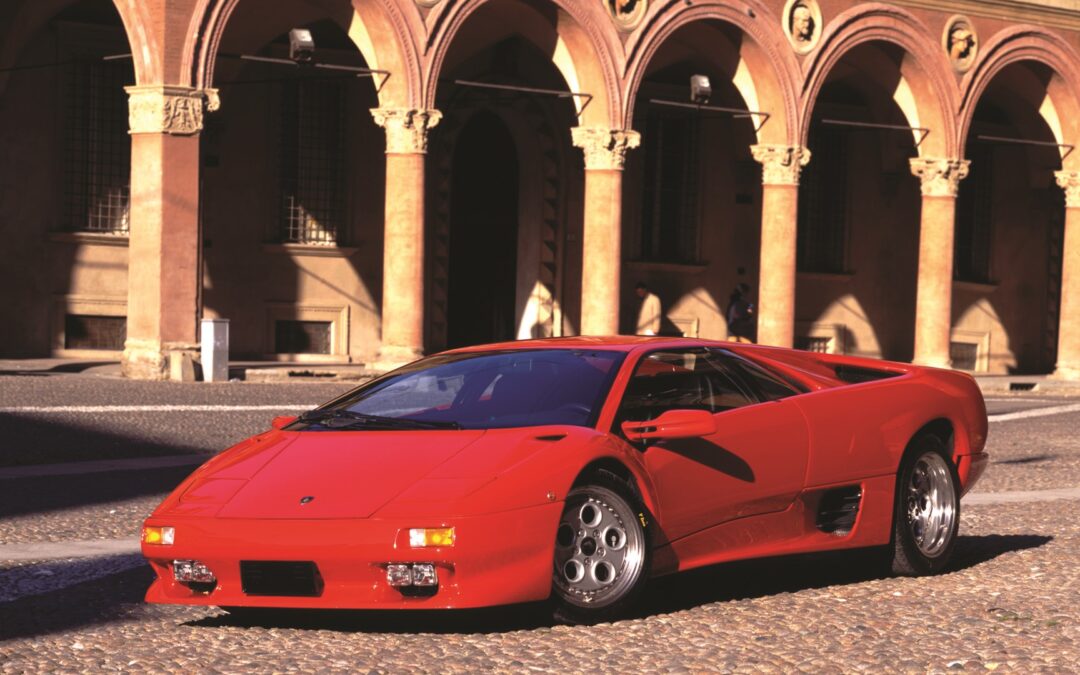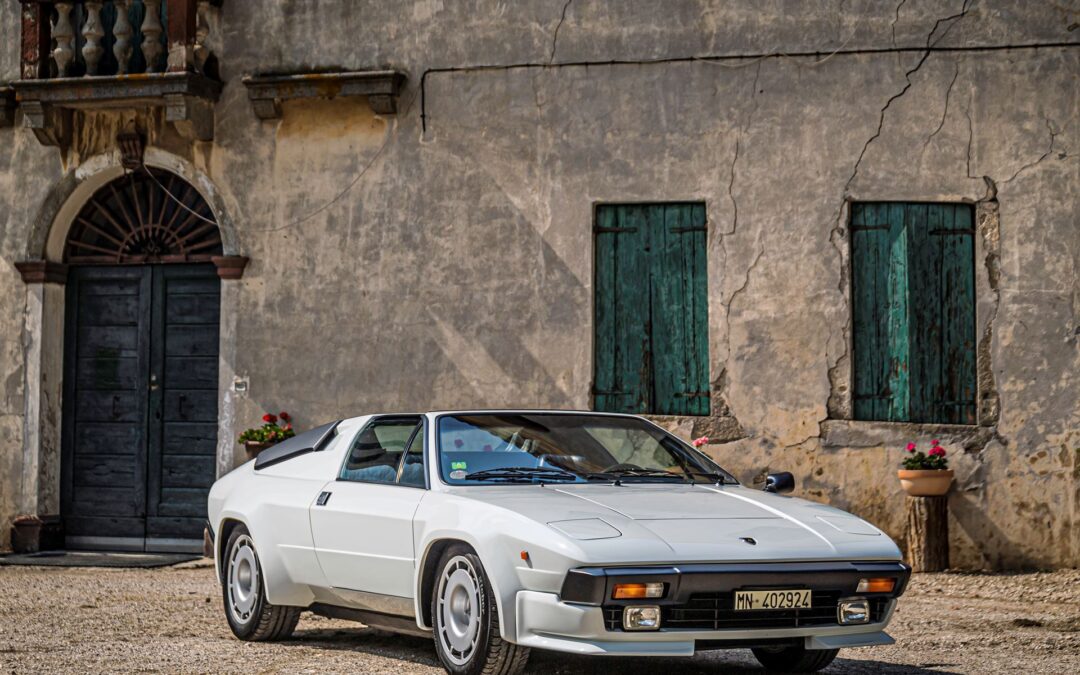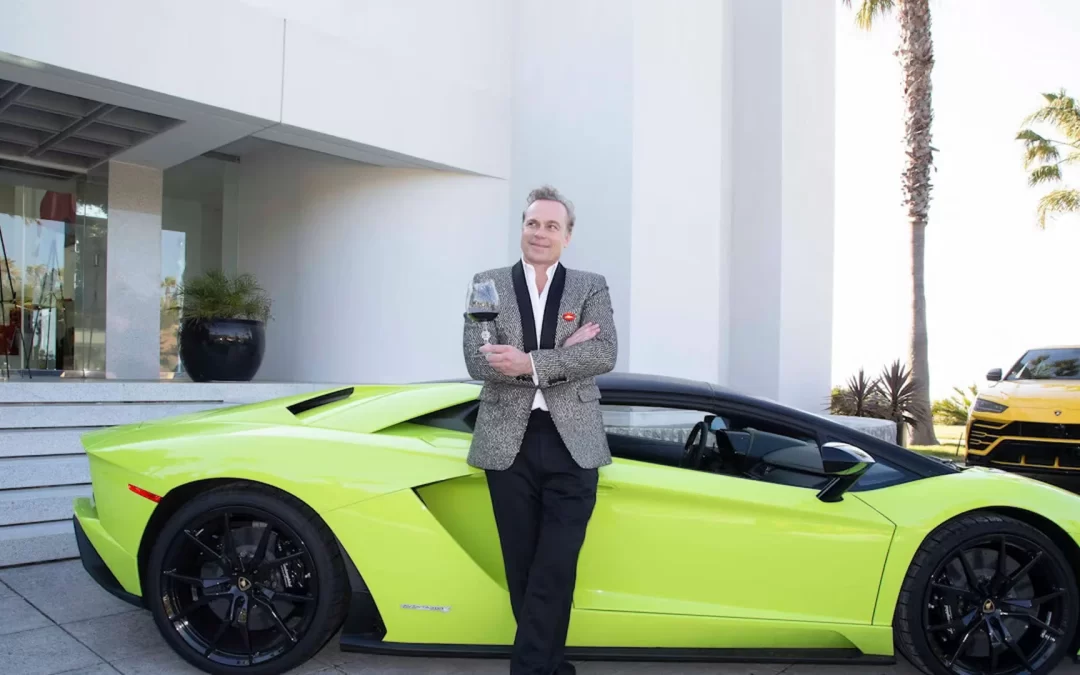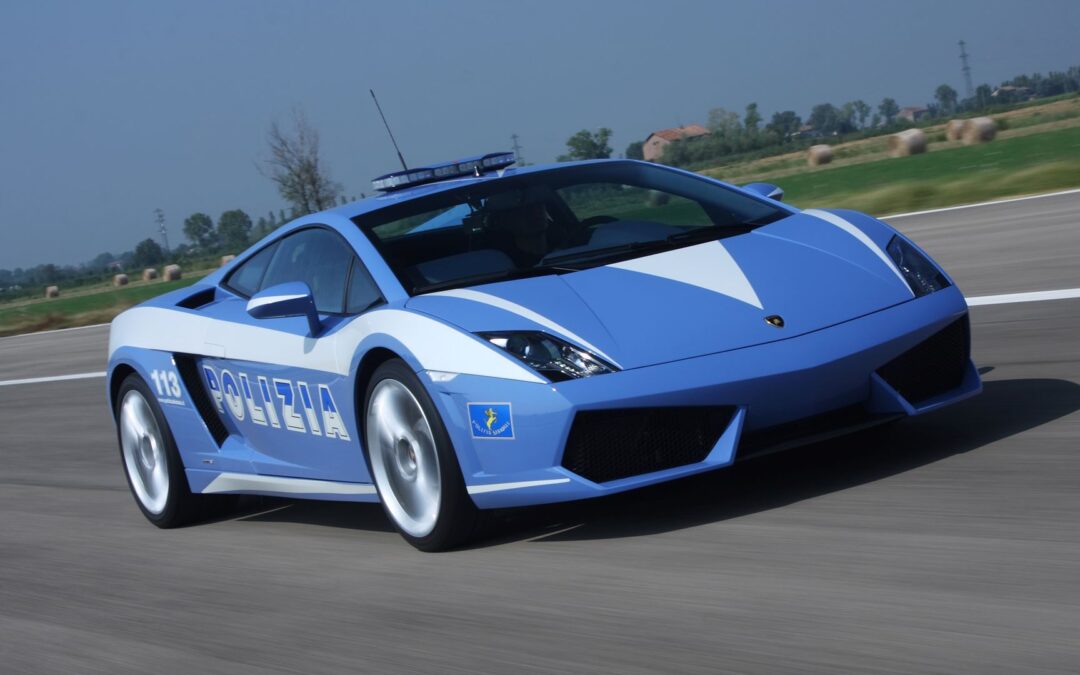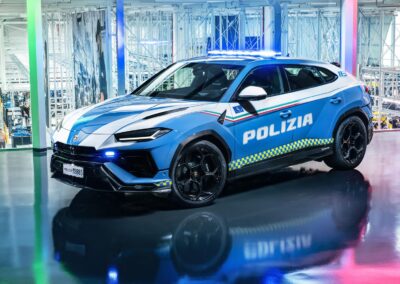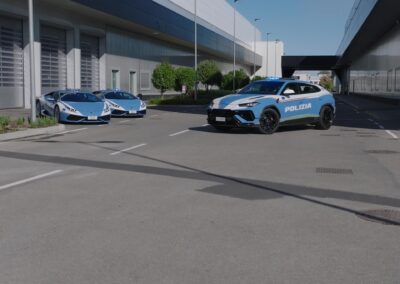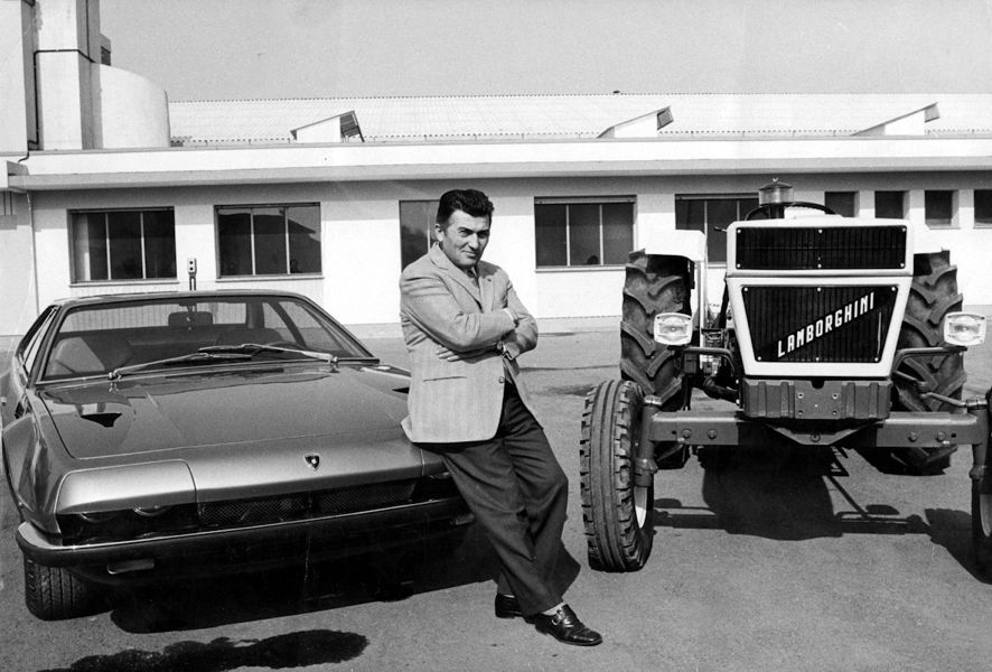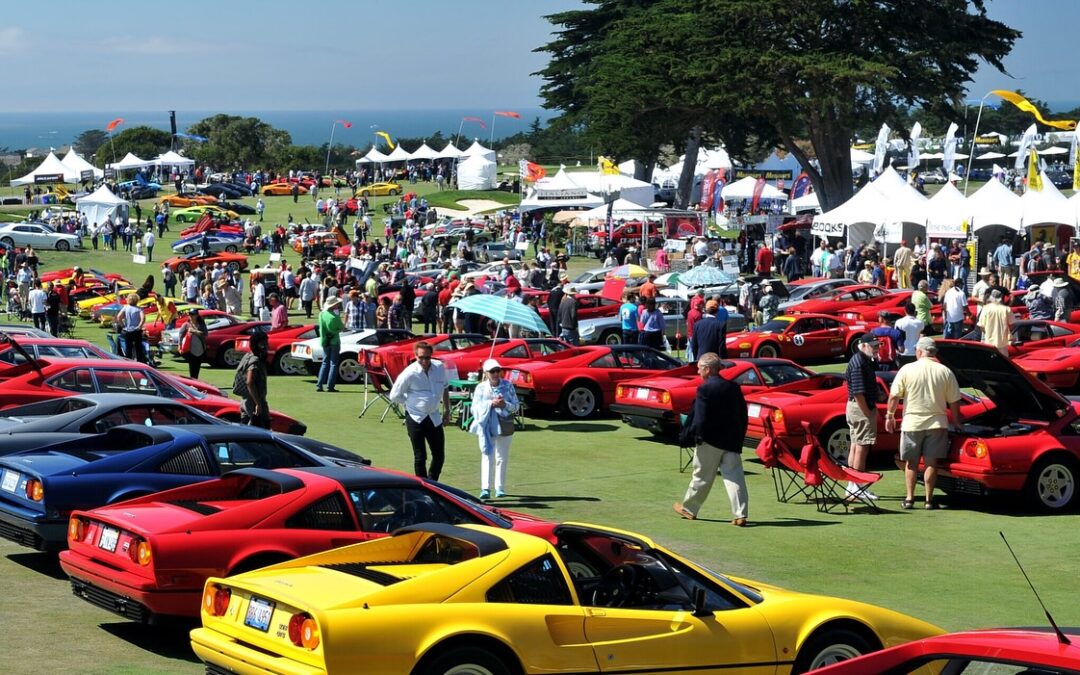
by Lamborghini Fan 1 | Feb 26, 2025 | Etcetera, Vintage / History
 The crisp, high-altitude air of St. Moritz became a canvas for Lamborghini’s rich heritage as the marque commenced its Polo Storico tenth-anniversary celebrations. The event, a blend of exclusivity and automotive artistry, transformed the renowned Swiss resort into a living museum of Lamborghini’s iconic past.
The crisp, high-altitude air of St. Moritz became a canvas for Lamborghini’s rich heritage as the marque commenced its Polo Storico tenth-anniversary celebrations. The event, a blend of exclusivity and automotive artistry, transformed the renowned Swiss resort into a living museum of Lamborghini’s iconic past.
The weekend’s centerpiece was undeniably the breathtaking Diablo SE 30, resplendent in “Lambo Thirty” purple. Perched dramatically on the Balthazar Downtown’s panoramic terrace, it appeared to defy gravity, a vibrant testament to Lamborghini’s audacious design philosophy. Below, on the frozen expanse of Lake St. Moritz, two more legends took their place: the Countach LP 400S, a veteran of the Monaco Grand Prix, and a meticulously preserved Miura SV.
The Countach, a symbol of 1980s automotive excess, was undergoing the rigorous Polo Storico certification process, a testament to the program’s dedication to authenticity. Its presence alongside the Miura SV, a car hailed as the world’s first supercar, underscored the breadth of Lamborghini’s historical significance. The Miura, a vision of elegance and power, was rightfully awarded the “Hero Below Zero” prize, a testament to its enduring appeal.
Alessandro Farmeschi, After Sales Director, emphasized the importance of community, highlighting the collaborative spirit that has defined Polo Storico’s first decade. The St. Moritz event, with its exclusive dinners and dedicated lounge, provided a platform for collectors and enthusiasts to share their passion and contribute to the preservation of Lamborghini’s legacy.
The celebrations are far from over. The journey continues to Rome, where the Anantara Concours d’Elegance will showcase Italian automotive masterpieces, with Lamborghini Polo Storico taking center stage once again. The echoes of the V12s in St. Moritz will resonate throughout the year, marking a decade of unwavering commitment to preserving the soul of Lamborghini.

by Lamborghini Fan 1 | Feb 21, 2025 | Vintage / History
The Lamborghini Diablo. The name itself conjures images of speed, aggression, and a healthy dose of 90s excess. It was a car that perfectly encapsulated the era, a wild beast of a machine that pushed the boundaries of performance and style. More than just a supercar, the Diablo became a cultural icon, a poster car that adorned the walls of bedrooms worldwide.
Replacing the legendary Countach was no easy task, but the Diablo rose to the challenge. Unveiled in 1990, it retained the wedge shape that defined Lamborghini’s design language, but with a more refined and aerodynamic aesthetic. While still undeniably aggressive, the Diablo’s lines were smoother, more sculpted than its predecessor. It was a modern supercar for a new decade.
Under the hood, or rather, behind the driver, resided a monstrous 5.7-liter V12 engine. This powerhouse, a descendant of the engines found in earlier Lamborghinis, produced a symphony of mechanical music, a visceral roar that could send shivers down your spine. Initially, it churned out around 492 horsepower, propelling the Diablo to a claimed top speed of over 200 mph, a truly mind-boggling figure at the time. Later versions of the Diablo boasted even more power, culminating in the ferocious 6.0-liter engine found in the GT and VT 6.0 models.
Driving the Diablo was an experience unlike any other. It was raw, visceral, and demanding. The steering was heavy, the clutch was unforgiving, and visibility was practically non-existent. But none of that mattered. The Diablo was about the feeling, the sheer adrenaline rush of controlling a beast, the intoxicating blend of power and drama. It was a car that commanded respect, a car that made you feel like a rock star.
The Diablo’s interior was a reflection of its time. While not as luxurious as modern supercars, it possessed a certain charm. Leather seats, a simple dashboard layout, and a chunky steering wheel created a driver-focused environment. It wasn’t about creature comforts; it was about the pure joy of driving.
The Diablo’s influence on automotive design is undeniable. Its aggressive styling, powerful engine, and sheer presence helped define the supercar of the 1990s. It appeared in movies, music videos, and video games, further solidifying its place in popular culture.
The Lamborghini Diablo was more than just a car; it was a symbol of an era. It was a wild, untamed beast that captured the imagination of a generation. It was a car that dared to be different, a car that pushed the boundaries of what was possible. Today, the Diablo remains a highly sought-after collector car, a reminder of a time when supercars were raw, visceral, and utterly captivating.

by Lamborghini Fan 1 | Feb 21, 2025 | Vintage / History
Lamborghini. The name evokes images of raging bulls, scissor doors, and screaming V12s. But nestled amongst these legendary beasts lies a lesser-known gem, a car that represented a different path for the Italian marque: the Lamborghini Jalpa. This often-overlooked model, with its targa top and V8 engine, offered a more accessible and, dare we say, practical Lamborghini experience.
Born in the 1980s, the Jalpa was intended to be Lamborghini’s entry-level model, a rival to the Ferrari 308 and Porsche 911. It was a departure from the extreme, often impractical nature of its V12 siblings, offering a blend of performance and usability that broadened Lamborghini’s appeal. Designed by Bertone, the Jalpa sported a clean, angular design that was very much of its time. While it shared some design cues with the Countach, it possessed a more restrained elegance, a subtle aggression that hinted at its performance potential.
Under the hood, or rather, behind the driver, resided a 3.5-liter V8 engine. This smaller displacement engine, while less potent than the V12s found in other Lamborghinis, still provided a thrilling driving experience. Around 255 horsepower propelled the Jalpa with surprising agility, and the car’s relatively light weight contributed to its nimble handling. It wasn’t just about straight-line speed; the Jalpa was a car that encouraged driver involvement, a machine that felt alive in your hands.
The Jalpa’s targa top added another dimension to the driving experience. With the roof panel removed, the open-air sensation heightened the connection to the road and the engine’s throaty roar. It was a car that could be enjoyed on a sunny afternoon cruise as much as it could be pushed to its limits on a winding road.
Inside, the Jalpa’s cabin was functional and driver-focused. Leather seats, a simple dashboard layout, and a three-spoke steering wheel created a classic sports car ambiance. While not as luxurious as some of its contemporaries, the Jalpa’s interior prioritized the driving experience, putting everything the driver needed within easy reach.
Despite its merits, the Jalpa’s production run was relatively short, lasting from 1981 to 1988. It faced stiff competition from its rivals and struggled to find its place in the Lamborghini lineup. Ultimately, only around 410 examples were ever produced, making it a rare and sought-after car today.
The Jalpa may not be as famous as the Countach or the Miura, but it holds a unique place in Lamborghini’s history. It represents a time when the company dared to explore a different path, offering a more accessible and practical supercar. It’s a reminder that Lamborghini isn’t just about extreme performance; it’s also about the passion for driving, the thrill of the open road, and the joy of connecting with a machine. The Jalpa might be the forgotten Lamborghini, but its legacy lives on, a testament to the company’s diverse and enduring spirit.

by Lamborghini Fan 1 | Feb 21, 2025 | Etcetera, Modern, Vintage / History
Napa Valley, renowned for its exquisite wines and breathtaking scenery, is about to become the backdrop for a new kind of celebration: the inaugural JCB Rally. This exclusive event, spearheaded by Jean-Charles Boisset in partnership with the Napa Valley Car Club, promises a thrilling blend of luxury, speed, and style.
Kicking off at the Napa Valley Car Club’s newly unveiled Car Barn in downtown Napa, the JCB Rally invites participants to embark on an unforgettable journey behind the wheels of exotic cars. Imagine cruising through the picturesque landscapes of Napa Valley, the roar of a high-performance engine echoing through the vineyards.
The rally begins with a touch of elegance, featuring a stop at the iconic Oakville Grocery. Participants will indulge in coffee and pastries, fueling up for the scenic drive ahead. From there, the caravan of automotive masterpieces will wind its way through Napa’s most stunning routes, offering drivers and passengers alike a unique perspective on the valley’s beauty.
The excitement culminates back at the Car Barn, where the celebration continues with a sophisticated champagne and caviar reception. This post-rally gathering provides an opportunity for participants to share their driving experiences, admire the impressive collection of cars, and network with fellow enthusiasts.
As an added bonus, participation in the JCB Rally includes a ticket to the Car Barn’s Anniversary Party later that evening. This exclusive after-party promises to be a memorable celebration, extending the day’s festivities into the night.
The JCB Rally is more than just a drive; it’s an experience. It’s a chance to indulge in the finer things in life – high-performance cars, exquisite food and drink, and the camaraderie of fellow enthusiasts – all set against the stunning backdrop of Napa Valley. Mark your calendars and prepare for an unforgettable adventure.
More information:
https://www.exploretock.com/jcbsthelena/event/532006/jcb-collector-rally

by Lamborghini Fan 1 | Feb 21, 2025 | Modern, Recent Models, Vintage / History
For two decades, a unique partnership has been quietly working to protect and serve the citizens of Italy. Since 2004, Automobili Lamborghini and the Italian “Polizia di Stato” have joined forces, combining cutting-edge technology, a shared commitment to safety, and a touch of Italian flair. It’s a collaboration that has not only put high-performance vehicles into the hands of law enforcement but has also made a tangible difference in countless lives.
The story began with the delivery of a Lamborghini Gallardo, a symbol of Italian engineering excellence, pressed into service for the Polizia di Stato. This wasn’t just a publicity stunt; it was the start of a long and fruitful relationship. Over the past 20 years, Lamborghini has provided a succession of high-performance vehicles, each one a valuable tool for patrolling Italy’s roads and responding to emergencies.
These aren’t just show cars. They are actively used in the line of duty. Perhaps the most impactful role these Lamborghinis play is in organ transport. To date, these specially equipped vehicles have completed over 200 such missions across Italy, often making the difference between life and death. The speed and reliability of these supercars are crucial in these time-sensitive operations.
Beyond emergency response, the Lamborghini-Polizia di Stato partnership extends to road safety education. These eye-catching vehicles have been featured in more than 1,500 events designed to promote safe driving practices and instill a culture of responsibility on the road. It’s a proactive approach, using the allure of these incredible machines to engage with the public and promote positive change.
“We are extremely proud to celebrate 20 years of collaboration with the Italian State Police, an institution we deeply respect for its daily work protecting the safety of Italian citizens,” stated Stephan Winkelmann, Chairman and CEO of Automobili Lamborghini. “Knowing that our vehicles have supported the police in their road operations and have contributed to saving lives is greatly gratifying. This cooperation represents the strong bond between Automobili Lamborghini and Italy and its institutions, despite our international outlook.”
Prefect Vittorio Pisani, Chief of Police – Director General of Public Security, echoed this sentiment: “The 20-year synergy with Automobili Lamborghini reinforces the Italian State Police’s commitment to fulfilling a delicate task such as urgent organ transport, an activity carried out in close collaboration with the National Transplant Centre. This helps to make one of the missions of the Polizia di Stato increasingly tangible, namely being of service to all citizens. The Lamborghinis in use, from the Gallardo to the most recent Urus, allow us to rely on cutting-edge equipment and technology, ensuring our specially trained drivers can carry out this vital service quickly and with maximum safety.”
Over the past two decades, six different Lamborghini models have joined the Polizia di Stato fleet, each one boasting specific characteristics and advanced technologies tailored to the demands of law enforcement and emergency response. This partnership is more than just a vehicle donation; it’s a testament to the power of collaboration, a commitment to public service, and a symbol of Italian pride. It’s a story of technology, safety, and civic commitment, driven by the passion and innovation that defines both Lamborghini and the Polizia di Stato.

by Lamborghini Fan 1 | Feb 20, 2025 | Motorsports, Vintage / History
While primarily known for their road-going supercars, the Italian marque also dipped its toes into the high-octane world of Formula 1, albeit for a relatively short period. Their foray, while not ultimately crowned with championship glory, left an indelible mark and a lingering “what if” in the minds of motorsport enthusiasts.
Lamborghini’s F1 story isn’t one of a full-fledged factory team. Instead, they primarily acted as an engine supplier, partnering with various teams throughout their involvement. Their journey began in the late 1980s, a time when turbochargers were king and F1 cars were pushing the boundaries of technology.
The Lamborghini engine, a powerful V12, was initially developed for the abortive “Project 12” F1 car. This project, intended to be Lamborghini’s own entry into the sport, never materialized, but the engine itself found a home with the French Larrousse team in 1989. The Lamborghini V12, with its distinctive sound and impressive power output, quickly gained a reputation. It was a beast of an engine, capable of producing competitive horsepower, but it also proved to be somewhat temperamental.
The partnership with Larrousse yielded some promising results, including a podium finish at the 1990 Japanese Grand Prix with driver Aguri Suzuki. This result showcased the potential of the Lamborghini engine and hinted at a brighter future. However, consistency proved elusive, and the relationship between Lamborghini and Larrousse was often strained.
Over the next few years, Lamborghini supplied engines to other teams, including Lotus. The legendary British team, steeped in F1 history, hoped that the Italian V12 would reinvigorate their fortunes. Unfortunately, the partnership didn’t deliver the expected results. Despite flashes of brilliance, reliability issues and a generally uncompetitive car hampered their progress.
Ultimately, Lamborghini’s F1 adventure came to an end in 1993. Financial constraints and a lack of consistent success contributed to their withdrawal from the sport. While they never achieved the championship wins they craved, their presence in F1 added a certain flair and excitement.
The Lamborghini V12 engine, even with its reliability issues, was a force to be reckoned with. Its raw power and distinctive sound made it a fan favorite. It was a testament to Lamborghini’s engineering prowess, even if it didn’t translate into sustained success on the track.
Lamborghini’s F1 story is a reminder that even the most iconic brands can face challenges in the demanding world of motorsport. While their time in F1 was brief, it wasn’t without its highlights. The roar of the Lamborghini V12 echoed through the grand prix circuits of the world, a testament to the passion and innovation that the Italian manufacturer brought to the pinnacle of racing. It’s a chapter in F1 history that, while short, is still remembered fondly by many. And it leaves us wondering what might have been had Lamborghini continued their F1 journey.

by Lamborghini Fan 1 | Feb 20, 2025 | Vintage / History
Sometimes, a car arrives not just as transportation, but as a seismic event. The Lamborghini Miura, unveiled in 1966, was such a car. It wasn’t merely fast; it was a revelation, a tectonic shift in the supercar landscape. Before the Miura, mid-engine exotics were the stuff of prototypes and whispered fantasies. Lamborghini, barely three years old, took that dream and hammered it into reality, forever altering the trajectory of performance automobiles.
Ferruccio Lamborghini’s tractor empire had given him the wherewithal, but it was a confluence of brilliant minds that birthed the Miura. Chief engineer Gian Paolo Dallara, along with Paolo Stanzani and Bob Wallace, envisioned a mid-engine chassis unlike anything seen before. This wasn’t just about putting the engine in the middle; it was about optimizing weight distribution, enhancing handling, and creating a machine that looked as otherworldly as it performed.
And then there was Marcello Gandini, Bertone’s young design maestro. Gandini penned a shape so audacious, so impossibly beautiful, that it stopped traffic even before it moved. The Miura’s low, sleek profile, its impossibly curvaceous fenders, and those iconic “eyelash” headlamp surrounds – it was pure automotive artistry. It wasn’t just aerodynamic; it was sensual.
The heart of the beast was a transversely mounted 3.9-liter V12, a masterpiece of engineering that screamed to its 7,500 rpm redline. Four Weber carburetors fed the beast, producing a claimed 350 horsepower, a figure that was simply staggering for the era. Imagine the sensation: that glorious V12 howl echoing behind you, the world blurring as you rocket towards an estimated 170 mph top speed. This wasn’t just about speed; it was about the experience.
The Miura wasn’t without its quirks. The early cars suffered from some teething issues, including less-than-ideal weight distribution and a tendency towards instability at high speeds. But these were minor blemishes on an otherwise brilliant canvas. Lamborghini, ever the perfectionist, addressed these issues in later iterations, culminating in the SV, the ultimate expression of the Miura.
The SV, with its wider rear tires, revised suspension, and subtly tweaked aerodynamics, tamed some of the Miura’s wilder tendencies while further amplifying its performance. It was the Miura as it was always meant to be: a visceral, thrilling, and ultimately captivating driving experience.
The Miura’s impact extended far beyond its performance figures. It democratized the mid-engine supercar, proving that such a layout wasn’t just for racing prototypes. It inspired a generation of designers and engineers, influencing the shape of supercars to come. It also cemented Lamborghini’s reputation as a disruptor, a company willing to challenge the established order and push the boundaries of what was possible.
The Lamborghini Miura wasn’t just a car; it was a cultural phenomenon. It graced magazine covers, adorned bedroom walls, and became an instant icon. It was a symbol of rebellion, of innovation, and of pure, unadulterated passion. It was, and remains, a shockwave that continues to reverberate through the automotive world. The Miura wasn’t just ahead of its time; it defined its time, and continues to inspire awe decades later. It’s a reminder that sometimes, the most revolutionary creations are born from a desire to challenge the status quo, to build something truly extraordinary. And in the Miura’s case, that extraordinary something happened to be a raging bull of a supercar.

by Lamborghini Fan 1 | Feb 20, 2025 | Vintage / History
Ferruccio Lamborghini, a successful tractor manufacturer, founded Automobili Lamborghini in 1963 with the ambition to build sports cars superior to Ferrari. This was spurred by a dismissive response from Enzo Ferrari regarding Lamborghini’s critique of his personal Ferrari. Lamborghini’s vision was clear: grand touring cars with powerful engines, luxurious interiors, and exceptional handling.
His team, including engineer Giotto Bizzarrini, developed a magnificent 3.5-liter V12 engine, the heart of early Lamborghini models. The 350 GT, unveiled in 1963, showcased this commitment to performance. Its successor, the 400 GT, further refined the formula, solidifying Lamborghini’s presence in the high-performance market.
The game-changer arrived in 1966 with the Miura. Its revolutionary mid-engine layout, stunning Bertone design by Marcello Gandini, and blistering performance redefined the supercar. The Miura wasn’t just fast; it was a symbol of Lamborghini’s innovative spirit.
Following the Miura’s success, Lamborghini produced the Espada, a four-seater grand tourer demonstrating versatility. The Countach, introduced in 1974, with its radical wedge shape, scissor doors, and aggressive styling, became an icon, a poster car for a generation, cementing Lamborghini’s reputation for visually stunning and instantly recognizable automobiles.
Despite these iconic models, Lamborghini faced financial instability throughout its early years, changing ownership multiple times. However, the Lamborghini spirit endured, fueled by passion and belief in the brand’s potential.
The 1980s saw Lamborghini continue to push boundaries with the rugged LM002 off-roader and the Diablo, which succeeded the Countach, continuing the legacy of extreme performance and striking aesthetics. The Diablo solidified Lamborghini’s position as a supercar leader, battling Ferrari for dominance.
In 1998, a pivotal moment arrived: the Volkswagen Group, specifically Audi, acquired Lamborghini. This provided financial stability and resources for research, development, modernized production, and model expansion.
Under Audi’s ownership, Lamborghini entered a new era. The Murciélago, Diablo’s successor, maintained the tradition of breathtaking design and ferocious performance. The Gallardo, a smaller, more accessible supercar, broadened Lamborghini’s appeal and significantly increased sales. These models, combined with a focus on quality and reliability, strengthened Lamborghini’s position in the luxury sports car market.
The 21st century saw Lamborghini continue to innovate. The Reventón, a limited-edition supercar inspired by fighter jets, showcased its commitment to cutting-edge technology. The Aventador, Murciélago’s successor, raised the bar for supercar performance. The Huracán, Gallardo’s successor, continued the tradition of exhilarating performance.
Lamborghini also expanded its lineup with the Urus, a super SUV blending Lamborghini performance and styling with SUV practicality. The Urus, while a departure, proved commercially successful, attracting a new customer base.
Throughout its history, Lamborghini has remained true to its founder’s vision. It has consistently pushed automotive engineering and design boundaries, creating cars that are not just fast and powerful, but also beautiful and iconic. From the Miura to the Countach to the Aventador and Huracán, Lamborghini has delivered vehicles that ignite passion.
Today, Lamborghini represents Italian excellence, a brand synonymous with performance, luxury, and exclusivity. The raging bull emblem symbolizes power and untamed spirit, representing the company’s commitment to creating the world’s most desirable supercars. As Lamborghini looks forward, it continues to embrace innovation, ensuring the raging bull’s roar continues for generations.

by Lamborghini Fan 1 | Jan 21, 2025 | Etcetera, Modern, Vintage / History
Mark your calendars for a celebration of automotive passion and Italian heritage! On October 5th, 2025, San Jose’s vibrant Little Italy will come alive with the sights and sounds of the annual Little Italy Car Show. This exciting event promises a day filled with classic cars, Italian culture, delicious food, and family fun.
This is one of the largest Italian car shows in the US! Lamborghini, Ferrari, Italian Motorcycles & more.
More Info:
https://www.littleitalysj.com/little-italy-san-jose-festival
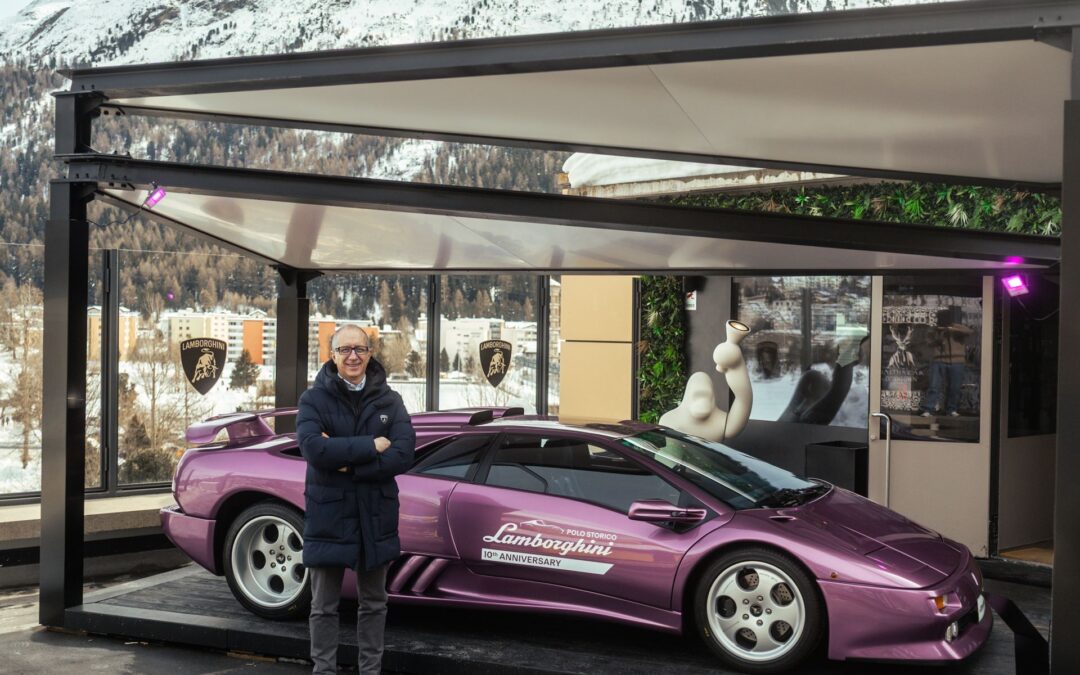
 The crisp, high-altitude air of St. Moritz became a canvas for Lamborghini’s rich heritage as the marque commenced its Polo Storico tenth-anniversary celebrations. The event, a blend of exclusivity and automotive artistry, transformed the renowned Swiss resort into a living museum of Lamborghini’s iconic past.
The crisp, high-altitude air of St. Moritz became a canvas for Lamborghini’s rich heritage as the marque commenced its Polo Storico tenth-anniversary celebrations. The event, a blend of exclusivity and automotive artistry, transformed the renowned Swiss resort into a living museum of Lamborghini’s iconic past.
